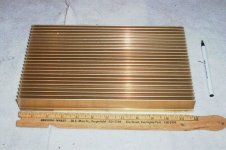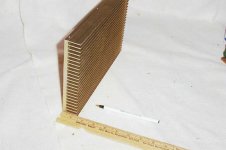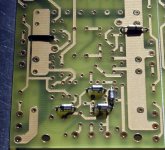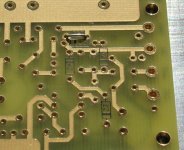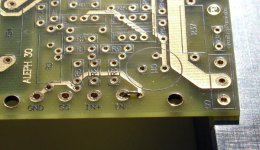I sent out all the board orders today. You should be receiving them middle of next week. There is still one bank transfer awaiting confirmation and cash payment that didn't make it yet from Europe.
Later on, I will post some additional info with regards to populating the boards, specifically the grounding options.
Later on, I will post some additional info with regards to populating the boards, specifically the grounding options.
Peter, that chassis looks great🙂 Really like that one.
Make sure the fan doesnt stop spinning though. Great as it looks, it seems a bit slim🙂 Maybe you ought to build in a warning light, in case the fan stops? Quite a design, how will it look when finished?
Steen.
Make sure the fan doesnt stop spinning though. Great as it looks, it seems a bit slim🙂 Maybe you ought to build in a warning light, in case the fan stops? Quite a design, how will it look when finished?
Steen.
I found an older thread dealing with mosfet type. Some might find it interesting, and that's probably where my choice of IRFP140 devices could be sourced to:
http://www.diyaudio.com/forums/showthread.php?s=&threadid=5185&highlight=
http://www.diyaudio.com/forums/showthread.php?s=&threadid=5185&highlight=
steenoe said:Peter, that chassis looks great🙂 Really like that one.
Before the Gainclones, I was pretty active with building class A amps. The chassis was always important to me, and you can see some examples of my previous work here:
http://www.diyaudio.com/forums/showthread.php?s=&threadid=5980&perpage=20&highlight=&pagenumber=1
http://www.diyaudio.com/forums/showthread.php?postid=52893#post52893
http://www.diyaudio.com/forums/showthread.php?s=&threadid=4561&highlight=
Regarding the fan, it's running at low speed, and judging by computer performance, PS usually gives up before the fan stops 😉
Originally I had plans on closing both sides, but now I kinda like the open architecture, and it's the first Aleph that has caps on a cold side. I will place 1/2 x 1 side bars at the fan and maybe a mesh on top, but that's probably all. I'm not concerned with appearance that much anymore.
Two of those might be OK for one channel, although depending on supply voltage, it may still run pretty hot. Aim for 24V maximum (which requires 2 x 18 V trafo) 😉
Last question. How about 2 of these per channel?
5 3/8 wide x 12" (could be longer), 1 inch fins, 21 fins, 3/8 base thinkness, 4.4 pounds/ft, .75c/w per 12" or better.
So I would use two per channel (10.75x12) with a 1/4" think copper heat spreader to join them and mount the mosfets.
I could make them as long as needed actually, maybe 15"...
5 3/8 wide x 12" (could be longer), 1 inch fins, 21 fins, 3/8 base thinkness, 4.4 pounds/ft, .75c/w per 12" or better.
So I would use two per channel (10.75x12) with a 1/4" think copper heat spreader to join them and mount the mosfets.
I could make them as long as needed actually, maybe 15"...
Attachments
Peter,
Does this amp borrow from a design you were thinking about
implementing for a Son of Zen?
It's nice to see some more work from you based around "manly" amps again. 😉
I hope you have the SOZ somewhere in the back of your mind still.
Would be neat to see what you come up with design wize, and
what you think of the sound quality.
I'm also interested in what you think of the Aleph 30.
(although i think i know already!) 🙂
thanks as usual for sharing.
Does this amp borrow from a design you were thinking about
implementing for a Son of Zen?
It's nice to see some more work from you based around "manly" amps again. 😉
I hope you have the SOZ somewhere in the back of your mind still.
Would be neat to see what you come up with design wize, and
what you think of the sound quality.
I'm also interested in what you think of the Aleph 30.
(although i think i know already!) 🙂
thanks as usual for sharing.
Actually, it is the chassis that was intended for SOZ. As I have all the parts for that amp, I will build it as well (one day).
Regarding the sound of Aleph 30, in some ways it is very good, showing great width and depth, with great musicality and instruments timbre. The bottom end is solid and well defined. However, I have one reservation, let me use the words from AX100 product brochure:
The sound of the XA amplifiers is a quantum leap over the parents. They retain the sweet warmth and lushness of the Aleph series without the fluffy coloration’s.
http://www.passlabs.com/downloads/xa100_om.pdf
So, on certain material (like Manger demo CD), the A30 sounds very good, to the point that I questioned GC superiority. But when it comes to material containing female vocals, I detect some softening and lack of precision in highs, and this what makes me go back to GC (as in this regard the smaller amp is still better). I suspect one area of improvement might be using better components: Caddocks, Mills, BG N, and that's what I want to try. Another area of improvement would be using two boards per channel as output stages, and by adding central, common input board, coverting setup into Aleph X (particularly 100 version). And that's what I plan on doing as well.
So you will see some more 'manly' amps coming from me ;-)
Regarding the sound of Aleph 30, in some ways it is very good, showing great width and depth, with great musicality and instruments timbre. The bottom end is solid and well defined. However, I have one reservation, let me use the words from AX100 product brochure:
The sound of the XA amplifiers is a quantum leap over the parents. They retain the sweet warmth and lushness of the Aleph series without the fluffy coloration’s.
http://www.passlabs.com/downloads/xa100_om.pdf
So, on certain material (like Manger demo CD), the A30 sounds very good, to the point that I questioned GC superiority. But when it comes to material containing female vocals, I detect some softening and lack of precision in highs, and this what makes me go back to GC (as in this regard the smaller amp is still better). I suspect one area of improvement might be using better components: Caddocks, Mills, BG N, and that's what I want to try. Another area of improvement would be using two boards per channel as output stages, and by adding central, common input board, coverting setup into Aleph X (particularly 100 version). And that's what I plan on doing as well.
So you will see some more 'manly' amps coming from me ;-)
Peter Daniel said:But when it comes to material containing female vocals, I detect some softening and lack of precision in highs,
I don't know why and if it may work or how , but in this regard I would
try for a pair of ZVP3306A instead of the IRF9610 in the differential pair .
😎
I received the PCBs five minutes ago. They look and feel great.
Thanks for your excellent work Peter!
Thanks for your excellent work Peter!
I noticed that the post is working really fast recently. The small package I sent to Australia on Friday, was alredy delivered yesterday.
I will be posting some additional info today, with regards to board stuffing.
I will be posting some additional info today, with regards to board stuffing.
All the parts numbers on the board correspond to parts numbers used in the A30 schematic, that can be found in this manual: http://www.passlabs.com/downloads/old product/a30manr0.pdf
If you wish to install protection diodes, they mount underneath, and should be installed first. Also, install 2 jumpers. Use either zero ohm jumpers (available from DK) or insulated wire in order to provide some clearance from the power traces (although the mask is there, it never hurts to be cautious).
If you wish to install protection diodes, they mount underneath, and should be installed first. Also, install 2 jumpers. Use either zero ohm jumpers (available from DK) or insulated wire in order to provide some clearance from the power traces (although the mask is there, it never hurts to be cautious).
Attachments
The grounds on board are separated and this allows individual connection to main power point. Some reported improvement, so I decided to make this possible. GND stands for constant current circuit ground and SG marks input ground. In case you don't want to run them separately, install jumper in place marked OPT (optional) and connect both grounds. In this case main ground connection is taken from GND point and signal ground (from from the input) connects to SG point.
Attachments
I configured my test board following recommendations from 2 previous posts (OPT jumper in place) and it was working fine.
There is also an option to configure grounds exactly like in A30 schematic, and here you mount R0 resistor (3ohm) and install R6 with a wider footprint (see the pic, and additional hole for that resistor). There is only one ground connection point on the board now (GND), you don't connect anything to SG, R6 connects directly to GND, all input shunting resistors from positive input connect to GND through R0.
There are 4 mounting holes in case you want to move output devices further away from the board. Use plastic standoffs to make sure you don't short any traces.
There is also an option to configure grounds exactly like in A30 schematic, and here you mount R0 resistor (3ohm) and install R6 with a wider footprint (see the pic, and additional hole for that resistor). There is only one ground connection point on the board now (GND), you don't connect anything to SG, R6 connects directly to GND, all input shunting resistors from positive input connect to GND through R0.
There are 4 mounting holes in case you want to move output devices further away from the board. Use plastic standoffs to make sure you don't short any traces.
Attachments
- Status
- Not open for further replies.
- Home
- Amplifiers
- Pass Labs
- The Aleph30 PCB layout
